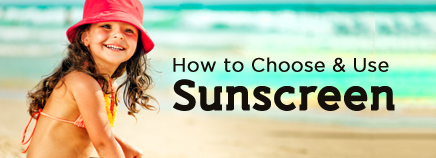
With all the sunscreens available these days (organic or mineral? water-resistant or sweat-resistant? lotion or spray?), choosing the right one for your kids can be tricky. But what matters most when picking a sunscreen is how well it protects skin from UV rays.
How to Choose
Look for SPF (sun protection factor) numbers on the labels of sunscreens. Select an SPF of 30 or higher to prevent sunburn and tanning, both of which are signs of skin damage. Choose a sunscreen that protects against both UVA and UVB rays (usually labeled as a “broad-spectrum” sunscreen).
Sunscreen sprays are convenient but should be used with caution. For starters, sprays are easy to breathe in, which can irritate the lungs. Some sprays also are flammable, so you need to avoid sparks or flames when applying them and wearing them. And, sprays make it hard to tell if you have applied enough sunscreen, which increases the risk of sunburn.
Other things to consider:
- Don’t use sunscreens with PABA, which can cause skin allergies.
- For sensitive skin, look for products with the active ingredient titanium dioxide.
- If your teen or preteen wants to use a self-tanner sunscreen, be sure to get one that also has UV protection (many offer little or none).
Babies younger than 6 months should be kept out of the sun. When going outside, dress your baby in lightweight clothes that cover arms and legs — and don’t forget a hat. If you can’t avoid the sun, you can use a small amount of sunscreen on your baby’s exposed skin, like the hands and face.
How to Use
For sunscreen to do its job, it must be used correctly. Be sure to:
- Apply sunscreen whenever your kids will be in the sun. For best results, apply sunscreen about 15 to 30 minutes before kids go outside.
- Don’t forget about ears, hands, feet, shoulders, and behind the neck. Lift up bathing suit straps and apply sunscreen underneath them (in case the straps shift as a child moves). Protect lips with an SPF 30 lip balm.
- Apply sunscreen generously — dermatologists recommend using 1 ounce (enough to fill a shot glass) to cover the exposed areas of the body.
- Reapply sunscreen often, about every 2 hours. Reapply after a child has been sweating or swimming.
- Apply a water-resistant sunscreen if kids will be around water or swimming. Water reflects and intensifies the sun’s rays, so kids need protection that lasts. Water-resistant sunscreens may last up to 80 minutes in the water, and some are also sweat-resistant. But regardless of the water-resistant label, be sure to reapply sunscreen when kids come out of the water.
- Don’t worry about making a bottle of sunscreen last. Stock up, and throw out any sunscreen that is past its expiration date or that you have had for 3 years or longer.
Every child needs sun protection. The American Academy of Dermatology (AAD) recommends that all kids — regardless of their skin tone — wear sunscreen with an SPF of 30 or higher. Although dark skin has more protective melanin and tans more easily than it burns, tanning is a sign of sun damage. Dark-skinned kids also can get painful sunburns.
And remember to be a good role model. Consistently wearing sunscreen with SPF 30 or greater and limiting your sun exposure will reduce your risk of skin damage and teach your kids good sun sense.

